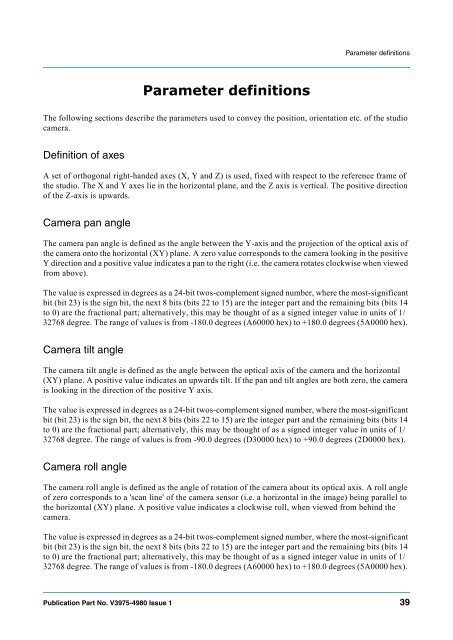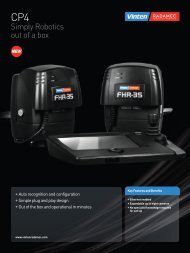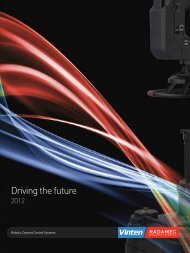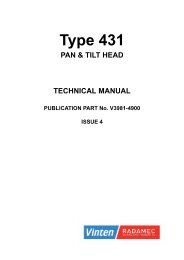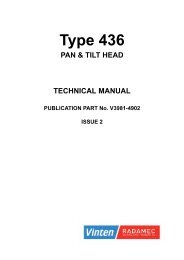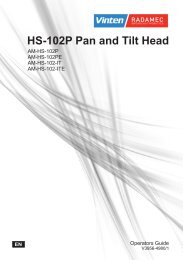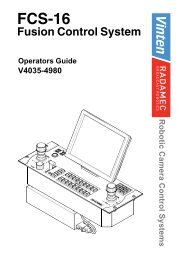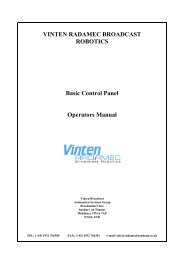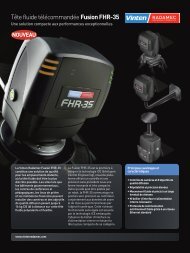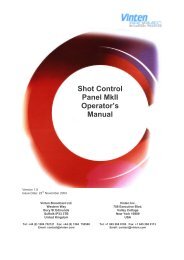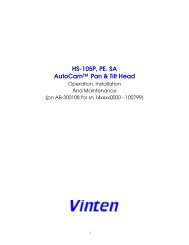free-d Virtual Studio System Operators Guide - Vinten Radamec
free-d Virtual Studio System Operators Guide - Vinten Radamec
free-d Virtual Studio System Operators Guide - Vinten Radamec
Create successful ePaper yourself
Turn your PDF publications into a flip-book with our unique Google optimized e-Paper software.
Parameter definitions<br />
Parameter definitions<br />
The following sections describe the parameters used to convey the position, orientation etc. of the studio<br />
camera.<br />
Definition of axes<br />
A set of orthogonal right-handed axes (X, Y and Z) is used, fixed with respect to the reference frame of<br />
the studio. The X and Y axes lie in the horizontal plane, and the Z axis is vertical. The positive direction<br />
of the Z-axis is upwards.<br />
Camera pan angle<br />
The camera pan angle is defined as the angle between the Y-axis and the projection of the optical axis of<br />
the camera onto the horizontal (XY) plane. A zero value corresponds to the camera looking in the positive<br />
Y direction and a positive value indicates a pan to the right (i.e. the camera rotates clockwise when viewed<br />
from above).<br />
The value is expressed in degrees as a 24-bit twos-complement signed number, where the most-significant<br />
bit (bit 23) is the sign bit, the next 8 bits (bits 22 to 15) are the integer part and the remaining bits (bits 14<br />
to 0) are the fractional part; alternatively, this may be thought of as a signed integer value in units of 1/<br />
32768 degree. The range of values is from -180.0 degrees (A60000 hex) to +180.0 degrees (5A0000 hex).<br />
Camera tilt angle<br />
The camera tilt angle is defined as the angle between the optical axis of the camera and the horizontal<br />
(XY) plane. A positive value indicates an upwards tilt. If the pan and tilt angles are both zero, the camera<br />
is looking in the direction of the positive Y axis.<br />
The value is expressed in degrees as a 24-bit twos-complement signed number, where the most-significant<br />
bit (bit 23) is the sign bit, the next 8 bits (bits 22 to 15) are the integer part and the remaining bits (bits 14<br />
to 0) are the fractional part; alternatively, this may be thought of as a signed integer value in units of 1/<br />
32768 degree. The range of values is from -90.0 degrees (D30000 hex) to +90.0 degrees (2D0000 hex).<br />
Camera roll angle<br />
The camera roll angle is defined as the angle of rotation of the camera about its optical axis. A roll angle<br />
of zero corresponds to a 'scan line' of the camera sensor (i.e. a horizontal in the image) being parallel to<br />
the horizontal (XY) plane. A positive value indicates a clockwise roll, when viewed from behind the<br />
camera.<br />
The value is expressed in degrees as a 24-bit twos-complement signed number, where the most-significant<br />
bit (bit 23) is the sign bit, the next 8 bits (bits 22 to 15) are the integer part and the remaining bits (bits 14<br />
to 0) are the fractional part; alternatively, this may be thought of as a signed integer value in units of 1/<br />
32768 degree. The range of values is from -180.0 degrees (A60000 hex) to +180.0 degrees (5A0000 hex).<br />
Publication Part No. V3975-4980 Issue 1 39


